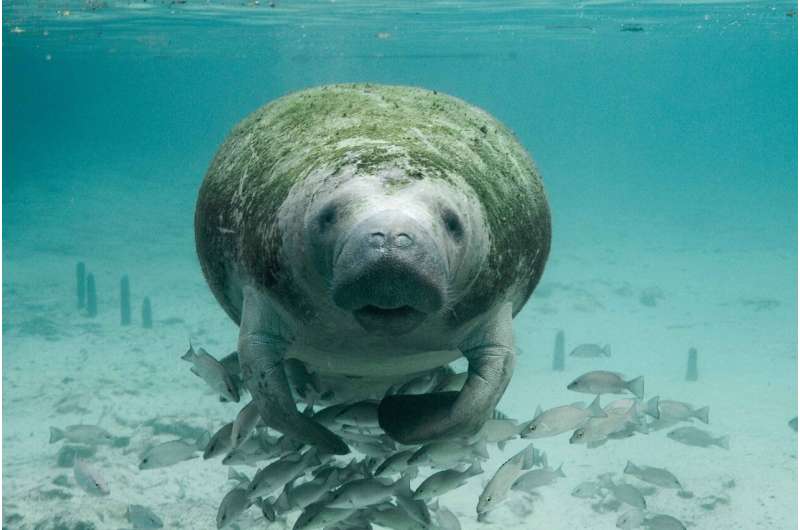Credit: Pixabay/CC0 Public Domain
A cold spell and plunge in water temperature often mean a death sentence for manatees, but those in the Indian River—despite harsh environmental conditions and widespread starvation—survived the Christmas freeze without an uptick in the death toll, authorities said.
"After the cold temperatures this past weekend, we are happy to report that we have not documented any carcasses or manatees in distress," said Michelle Pasawicz, a state biologist stationed at the Florida Power & Light Co. plant along the Indian River in Brevard County, the epicenter of an unprecedented manatee die-off.
"But of course we will continue to monitor the area as it is still possible that some of these animals cannot make it," Pasawicz said.
Titusville's low temperature on Dec. 23 just before the cold snap was 58 degrees. The next day saw a dip to 31, Christmas had a low of 29, Monday's low also was 29, and Tuesday's lowest temperature climbed to 38.
Manatees cannot tolerate prolonged exposure to water temperatures of less than 68 degrees, according to the Florida Fish and Wildlife Conservation Commission.
Ron Mezich, a commission biologist overseeing efforts to feed manatees at the FPL plant, said the Christmas cold front "came through pretty hard."
The lowest recorded water temperature, observed at the Max Brewer Bridge in Titusville and north of the FPL plant, was 51 degrees Tuesday morning.
"We think that will be the low low of this cold front," Mezich said Wednesday. "Yesterday afternoon, temperatures had reached up to 53—still very cold." He expected water temperatures to climb into the 60s in coming days.
By Christmas, staff at the FPL plant, where manatees were fed 200,000 pounds of lettuce last winter, observed as many as 29 manatees, Mezich said.
During the previous two winters, manatee deaths spiked in Brevard County's Indian River with drops in water temperatures. State experts blamed, in general, a lethal combination of cold and manatees being exhausted and in poor condition as a result of starvation.
The animals' prime food, seagrass, has been decimated in Brevard's section of the Indian River by water pollution and a harmful convulsion in environmental conditions.
Well into last winter, the FPL feeding site was crowded at times with manatees.
"The 20 to 30 number we are seeing this year is small compared to last year's average," Pasawicz said. "We had anywhere from 150 on most days last year to a high count of around 800."
State wildlife authorities recently noted that manatees this winter appear to be in better condition than during last winter, showing fewer signs of emaciation, physical distress and impaired movement. They cautioned that their observations were from a relatively small number of the animals.
To some extent, authorities attribute improvement in manatee condition to increased availability of seagrass in the Mosquito Lagoon portion of the Indian River north of TItusiville and adjoining Canaveral National Seashore.
"Right now is still a small number but it is good news for us," Pasawicz said. "We want to see that they are being independent and finding sources of food elsewhere."
2022 Orlando Sentinel.
Distributed by Tribune Content Agency, LLC.






















